page 9
Note: the contents of this page as well as those which precede and follow, must be read as a continuation and/or overlap in order that the continuity about a relationship to/with the dichotomous arrangement of the idea that one could possibly talk seriously about peace from a different perspective as well as the typical dichotomous assignment of Artificial Intelligence (such as the usage of zeros and ones used in computer programming) ... will not be lost (such as war being frequently used to describe an absence of peace and vice-versa). However, if your mind is prone to being distracted by timed or untimed commercialization (such as that seen in various types of American-based television, radio, news media and magazine publishing... not to mention the average classroom which carries over into the everyday workplace), you may be unable to sustain prolonged exposures to divergent ideas about a singular topic without becoming confused, unless the information is provided in a very simplistic manner.
Let's face it, humanity has a lousy definition, accompanying practice, and analysis of peace.
BR>
In speaking of Peace, we can't help but notice that it frequently assumes a position of distinction thought be opposite that of war or otherwise named conflict. In other words, it is an example of an oppositional form of duality instead of as either a compliment (supportive) or complement (attached part there of). As a mental construct it exhibits what we can describe as a two-patterned example of thinking. And though from this one example one may not want to conclude in the existence of a conservation of overall mental activity, despite the many examples thus far already presented, it nonetheless represents a type of thinking in a recognizable form. However, the idea of arranging things in patterns-of-two has an ancient history as described in the following illustrations:
Table of Opposites In Pythagorean philosophy, a set of 10 pairs of contrary qualities. The earliest reference is in Aristotle, who said that it was in use among some contemporary Pythagoreans. But Aristotle provided no real information about its function in Pythagorean practice or theory or about its origin. Some scholars have detected possible archaic elements in it, but others have suggested that its originator was in fact Speusippus, Plato's nephew. Because no statements of Pythagoras have survived, and because Aristotle customarily accommodated pre-Socratic philosophy to his own terminology and problems, the problem is difficult to resolve. Aristotle's table of the Pythagorean opposites is as follows: | ||||||||||||||||||||
| ||||||||||||||||||||
|
Aristotle remarked that Alcmaeon of Croton, a medical writer, also had pairs of contraries as the first “principles” of things and also of most human things, but he did not know whether contemporary Pythagoreans influenced Alcmaeon in this regard or vice versa. Aristotle associated moral prestige with the left-hand column, because the “good” things appear in that column. The table had some currency among Aristotle's contemporaries, perhaps in the Academy (Plato's school in Athens), but his references are made merely in the interest of supporting certain views of his own. Aristotle's formal table has 10 members, because the Pythagoreans considered 10 the perfect number. But the pairs varied in different authors. Possibly no list or set number of opposites became canonical among the Pythagoreans. Source: "Opposites, Table of." Encyclopædia Britannica Ultimate Reference Suite, 2013.Alcmaeon (also spelled Alcmeon) Flourished 6th century BC(Alcmaeon was a) Greek philosopher and physiologist of the academy at Croton (now Crotone, southern Italy), the first person recorded to have practiced dissection of human bodies for research purposes. He may also have been the first to attempt vivisection. Alcmaeon inferred that the brain was the centre of intelligence and that the soul was the source of life. Applying the Pythagorean principle of cosmic harmony between pairs of contraries, he posited that health consists in the isonomy (equilibrium) of the body's component contraries (e.g., dry-humid, warm-cold, sweet-bitter), thus anticipating Hippocrates' similar teaching. Source: "Alcmaeon." Encyclopædia Britannica Ultimate Reference Suite, 2013. |

However, the Western culture tends to exhibit a rather disquieting ego in its arrogance for dismissing reports about more ancient ideas such as the I-Ching, with its "Complementary" form of duality which portrays a symbol related to the concept of a Yin+Yang unity. However a present day variation exhibits a three-patterned formula of Yin-Unity-Yang, that coincides with the Western syllogistic formulas such as [(Theses + Anti-thesis) = Synthesis], [(Major Premise + Minor Premise) = Conclusion], etc., which are two examples exhibiting an oppositional character grouping first, and then a third cumulative expression. When looked at holistically, such examples are miniaturized historical descriptions of a developmental mental change with a "two-based" origin proceeding to a three-based formulation, similar to the stopping point at "2" of early counting systems... clearly evident in the counting phrase "one, two, many".

X large, XX large, XXX large ... are little more than 3 repetitious extensions to the previous concept of "large".
(Ones- Tens- Hundreds) is a group set reflecting a conservation of thinking. In order to go "beyond" this limitation, we repeat ourselves by adopting a (thousands- ten thousands- hundred thousands) concept which is just another set of the previously used three-patterned limitation that is followed by a "comma". In effect, the usage of a comma becomes a point of demarcation that gives us the false impression that we are thinking beyond the three-patterned mental limitation, but we aren't— because we are subjected to environmental conditions that impose a survival requirement of cognitive limitation on us. The planet Earth is actually forcing us to adapt to deteriorating environmental conditions which are killing us like a slow acting poison that... because of religious and cultural traditions, we rationalize as being beneficial... and adopt supportive ideas, ceremonies and imagination to go along with an incremental plodding amounting to humanity's funeral procession. Death is still death no matter how colorful, how ceremonial, or how much money is made off of it.
Again, it's not that humanity is incapable of larger and more complex concepts, it's just that it is physiologically (biologically/genetically) and mentally (as an extension of the physical), we are forced into exhibiting an relying on a conservation of concepts and related expressions as a survival mechanism in a decaying environment. Let's now take a closer look at the Yin/Yang/I-Ching idea (noting that it reflects a similarity to the divination associated with ancient Astrology):
Yijing Chinese “Classic of Changes” or “Book of Changes” Wade-Giles romanization I-Ching or Yi-Ching, also called Zhou Yi. (The I-Ching is) an ancient Chinese text, one of the Five Classics (Wujing) of Confucianism. The main body of the work, traditionally attributed to Wenwang (flourished 12th century BC), contains a discussion of the divinatory system used by the Zhou dynasty wizards. A supplementary section of "commentaries" is believed to be the work of authors of the Warring States period (475–221 BC) and, as a philosophical exposition, represents an attempt to explain the world and its ethical principles, applying a largely dialectic method. For this the work came to have great importance in the history of Chinese philosophy. Modern scholars, nevertheless, have been troubled by the inclusion of the Yijing among the Confucian classics, for Confucius (551–479 BC) seems to have deliberately avoided speaking of anything that suggested esoteric doctrines. The answer seems to be that Han dynasty Confucianists (c. 2nd century BC), influenced by the Daoist quest for immortality, justified their use of the Yijing by attributing certain of its commentaries to Confucius. Though the book was originally used for divination, its influence on Chinese minds and its universal popularity are due to a cosmology that involves humans and nature in a single system. The uniqueness of the Yijing consists in its presentation of 64 symbolic hexagrams that, if properly understood and interpreted, are said to contain profound meanings applicable to daily life. Throughout the ages, Yijing enthusiasts have claimed that the book is a means of understanding, and even controlling, future events. The Yijing hexagrams are formed by joining in pairs, one above the other, eight basic trigrams (bagua). Each trigram has a name, a root meaning, and a symbolic meaning. The legendary emperor Fuxi is said to have discovered these trigrams on the back of a tortoise. Wenwang is generally credited with having formed the hexagrams. In practice, one "creates" a hexagram by casting lots in one of several ways. The hexagram is built up from the bottom, line by line, by successive lots. Solid lines have the number nine, and broken lines have the number six. Solid lines represent yang (the male cosmic principle), while broken lines represent yin (the female cosmic principle). These two principles explain all being and all change by their ceaseless interaction. Individual lines of a hexagram have been compared to single notes of music. Though each note has a quality and significance in itself, its truest significance depends on its place in a musical score. Because the same principle applies to individual lines of a hexagram, the Yijing text first explains each line separately, then gives an overall interpretation of the unit. The text is often expressed in cryptic, thought-provoking language, thus allowing the user great leeway in interpreting its significance. Source: "Yijing." Encyclopædia Britannica Ultimate Reference Suite, 2013.The 64 hexagrams are composed from:  Yin — a broken/split line (no doubt referring to the contour/impression of the vagina)
Yin — a broken/split line (no doubt referring to the contour/impression of the vagina)Yang - a solid line (no doubt referring to the contour/impression of the penis) These 2 lines form: — 4 line pairs or ‘bigrams’ — and 8 ‘trigrams’ of 3 lines: 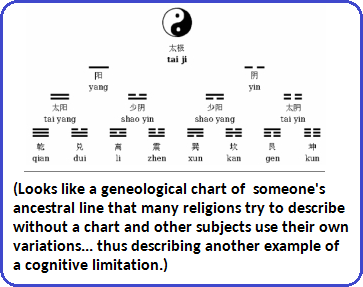 |
|
a ‘hexagram’ of 6 lines and 8 X 8 trigrams create 64 hexagrams: 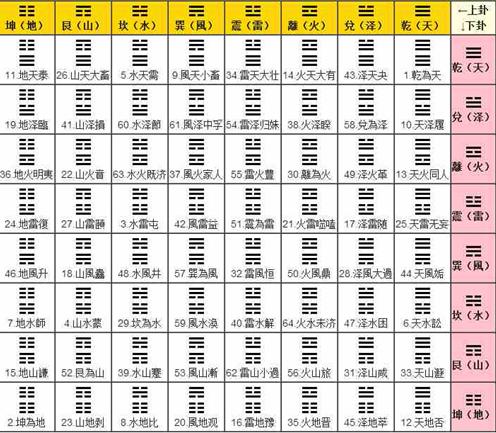 Source: Wisdom of Polarities: 3D Metric Universe |
|
Here's another version of the chart: 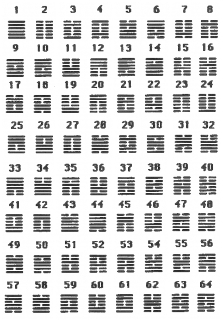 |
The problem we encounter with the idea of existing "trigrams" is that they are actually "bigrams". Like the previously mentioned organizations of "Major Premise- Minor Premise, Conclusion" and "Thesis- Anti-thesis, Synthesis", a "two" formula is evident though posed as an oppositional that is then transformed into an additive property resulting in a third... singular expression. While the so-called "trigrams" do contain three placements of lines, the quantity of lines does not exceed the value of "2". If there are been a third type of gender or if ancient Chinese could have conceptualized the world without resorting to a "self-centeredism" like those who once though the Sun revolved around the Earth. Take another look at the 8 so-called trigrams:

From one expression (one line), to another expression (two lines), yet there is no actual three-line composition as the following image displays:
 |
 |
This "one and two-line" schematic is but another example of a cognitive limitation that humanity persists in using, though the words and diagrams change over time. The basic formula does not change and you should not rush to defend it just because your philosophy/belief uses some variation thereof. We are not trying to describe ignorance, but the existence of an environmentally imposed situation that is detrimental to the survival of the species. It is rather stupid to defend something that is causing humanity to adopt a way of thinking (in multiple variations) that reflects the influence of a deteriorating planetary environment.
By using the words "Biad" for two lines and "Monad" for two lines, we can derive the following examples:
 |
 |
 |
There is no TRIAD, like there is an absence of a number (quantity) value beyond "2" in early counting systems... which, as denoted by our present day numbering system has reached 3 number places, but repeats this system by inserting a coma to separate sets-of-three... not sets of four, sets of five, sets of six, etc... Just because we can amass a billion examples of "2" or compound a single/double configuration does not mean we have cognitively surpassed the fundamental organizational pattern of concept formation. Humanity is cognitively stuck regardless of all the elaborations being used to give the impression of presumed "higher" thinking. It can't think past the third value. Compounding the "three" does not mean humanity has exceeded the value of three... just like we do not construct another word beyond the "large" size. We simply repeat ourselves. This is the same thing we're doing with respect to the concept of "peace", which is in an extremely primitive stage of development, much in the manner a primitive mind would conceive of the value "1". Nonetheless, Peace will never achieve an ultimate realization because humanity is subjected to deteriorating environmental conditions that are leading us to our grave... if we persist in remaining on Earth.
Another application of the "two"-pattern orientation is found in the old Morse Code language involving dashes and dots. If we substitute the one and two line symbolism (and intervening spaces) with dots and dashes, we can come up with the following example (though you might want to develop an alternative):
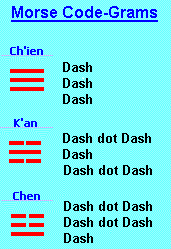
A bit more imagination can help us to develop the following associations:
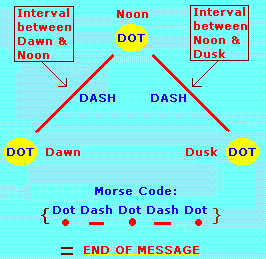 |
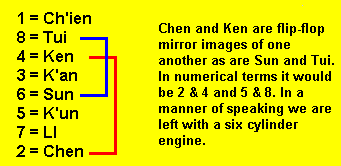 18436572= firing order of a Chevy V-8 engine |
Here are two additional views of the yin/yang trigrams perspective, with the 1st one related to the "64" quantity of amino acids and the second related to the 3 -to- 1 ratio found in DNA and RNA:
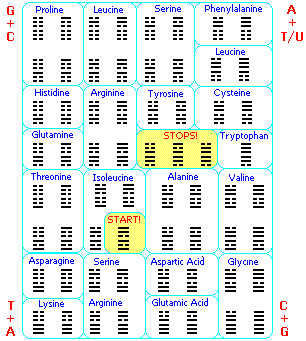 |
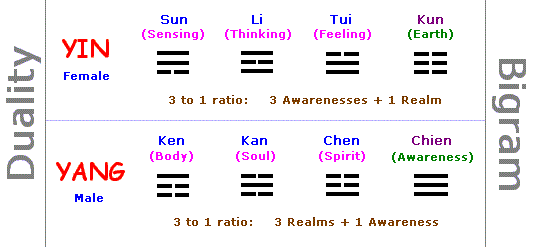
|
In our excursion to bring a bit of information about the "Duality" in the I-Ching which came after a short list was provided containing a few examples of opposites supposedly from ancient Greece, let us follow up with some dualities associated with the Yin/Yang concept:
Let's begin this page by starting off with a short poem about Two's:
|
Twos Why are lots of things in twos? Hands on clocks, and gloves and shoes, Scissor-blades, and water-taps, Collar studs, and luggage straps, Walnut shells, and pigeons? eggs, Arms and eyes and ears and legs-- Will you kindly tell me who?s So fond of making things in twos? John Drinkwater - 1882-1937 |
- Perhaps when the poem was written most clocks were being designed with only an hour and minute hand. With the advent of the second hand, we have three.
- While having a pair of gloves is customary, gloves can be fully-fingered, partially-fingered, or of the mitten type, though multiple specialized gloves are designed as well.
- As for shoes, we could mention the two tongues and our own tongue, not to mention that some people "run" at the mouth.
- While scissor-blades remain two, shaving blades have progressed from a single to a four-blade variety at this Jan. 15th 2012 writing. However, cooling fan blades remain predominantly three-bladed, lawn mower blades can have one or more, but ice skates still spout a single blade.
- Water-taps still come in the hot/cold designations although we now frequently see faucets designed with a single handle and in some stores, public restrooms have automatic dispensing water spouts.
- In terms of changing fashions, we don't see too many people wearing either collar studs or cuff links very often.
- With respect to luggage straps, most now have one or more zippers, with a few suitcases still sporting the old fold-down metal clasps.
- Walnut shells still come in two halves and most of us generally think in terms of opening a shell by divisionary terms, even if the "two" is not specific.
- At this moment, I'm not familiar with the quantity of eggs that pigeons may or may not have at any one time. It should be mentioned however, that pigeons very nearly went by way of the Dodo bird, but have made somewhat of a comeback. I can remember as a child they seemed to be everywhere.
- Most people are still born with two arms, eyes, ears and legs, though some people have attempted to carry a quantity of items suggesting three arms. Others say they have a third (mind's) eye and third (intuitive) ear. And I have had the occasion of witnessing some people using their mouth as if it were a third hand and still others using a cane as if it were a third leg.
| Yin | Yang |
|---|---|
| Feminine | Masculine |
| Negative | Positive |
| Moon | Sun |
| Darkness | Light |
| Yielding | Aggressive |
| Left side | Right side |
| Warm | Cold |
| Autumn | Spring |
| Winter | Summer |
| Unconscious | Conscious |
| Right brain | Left brain |
| Emotion | Reason |
Date of Origination: Friday, 16-Dec-2016... 06:40 AM
Date of initial posting: Monday, 19-Dec-2016... 09:31 AM
Updated posting: Saturday, 31-March-2018... 11:35 AM